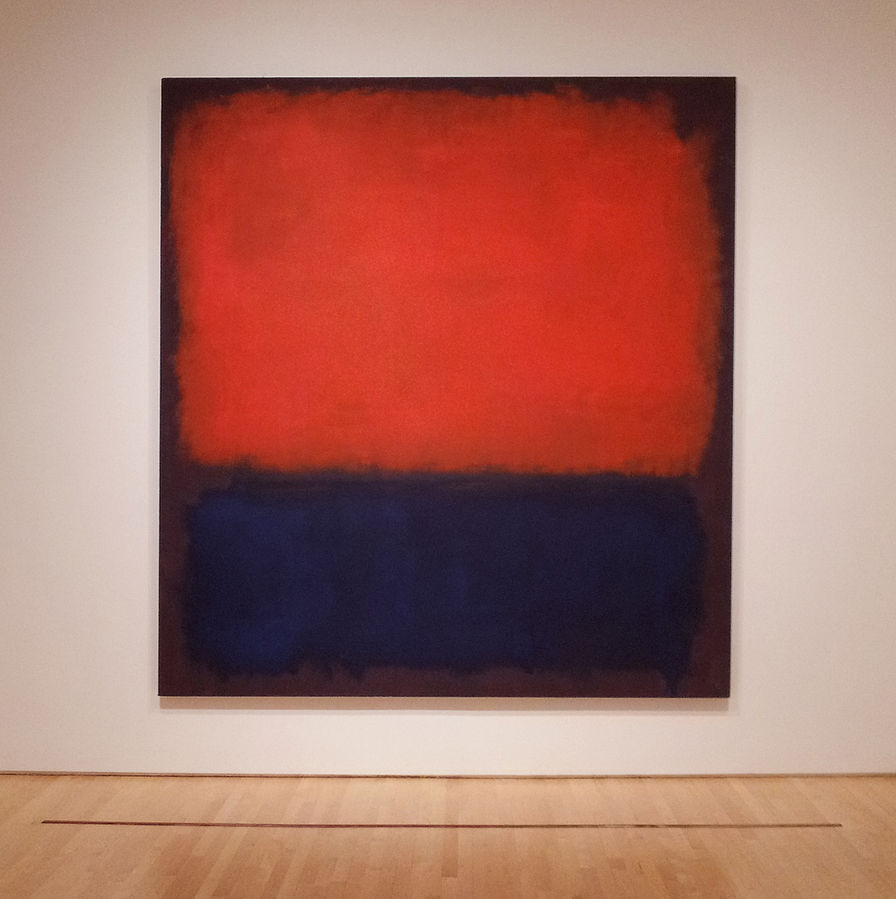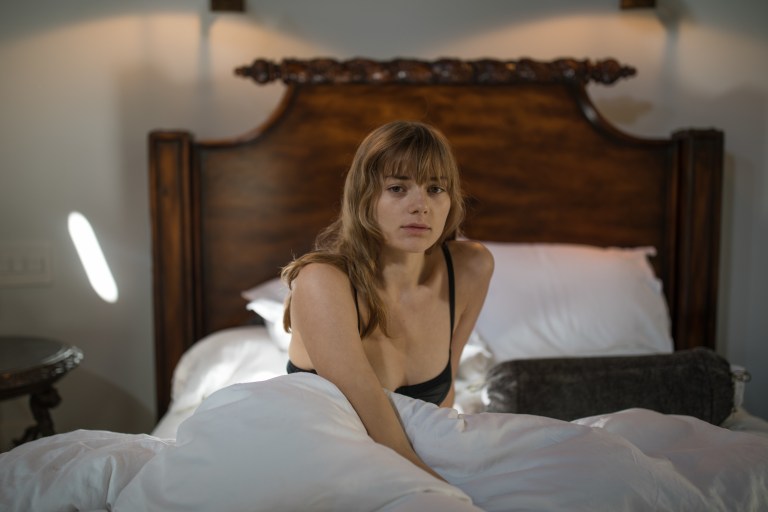Art Is Powerful, You Just Need To Open Yourself Up To It


There isn’t a manual that teaches viewers how to engage with art, so how do people know how to look at a work of art? How do people understand it? Can it even be understood? For me, it took some work and persistence in order to really see the abstracted visuals before me and attempt to understand the artist’s intentions.
It began my sophomore year of college in my “Visual Theory, Aesthetics and Criticism” class. I sat in the second row and listened to my favorite professor, Gary, go on his intellectual rant about a philosopher and his (or her) theoretical view of art. On one particular day in class, Gary put on a documentary presented by Simon Schama, entitled “Power of Art – Rothko.” I zoned out a bit, but tried to follow Schama’s discussion about Abstract Expressionist, Mark Rothko. Schama went on about Rothko’s life and how his work speaks to viewers. Towards the end of the movie, Schama described one of the paintings before him as displayed in 1970 at the Tate Gallery in London.
In the middle of the painting, entitled Red on Maroon, is a square-like form with the corners stretched a bit towards the edges of the canvas. The paint indicating this is slightly lighter than the rest of the maroon paint on the canvas and has a bit of a light gradient towards the center of the painting.
Simon Schama’s description confused me. I couldn’t understand, or see, what he could see. “A hanging veil suspended between two columns. An opening that beckons or denies entrance. A blind window. For me, it’s a gateway,” he said. What is this gateway? What did that mean? What can’t I see?
Several minutes later, the documentary ended and class commenced. I decided that I could not leave class as I would any other day; I needed to understand what Schama meant. I needed to understand why I was blind to such profound work.I packed up my bag and walked up to Gary.
“Intense shit, right?!” He was so excited.
“I didn’t get it,” I replied.
The smile stretched across his face turned into a look of complete shock. “You’re kidding me?” I moved my hand over my head to indicate that I didn’t understand Schama’s analysis, that it went over my head and got lost. Without missing a beat, in complete urgency, Gary instructed me to go with him to his office.
His small office contained an extensive library with books stuffed as neatly as possible into several small bookshelves throughout. I sat down. I explained to him that I couldn’t see what Rothko was trying to show in his paintings. I insisted that I could make the same painting because it seemed “thoughtless” and “easy.” I could see that my comment irritated him but I didn’t, and couldn’t, take it back. He responded:
“You’re not entitled to that opinion because you simply don’t know what it is you’re talking about. It’s your job to do the research, to educate yourself, to attempt to understand what it is that Rothko is trying to convey. Art isn’t going to speak to you and tell you what it is trying to show.” He handed me several books to buy and read immediately, insisting that this would allow for me to open my eyes and begin to understand the complexities of the artist. The first book was Rothko’s autobiography, The Artist’s Reality: Philosophies of Art, which was published by Rothko’s son after the artist’s death. The second was Tom Wolfe’s The Painted Word, which discussed how to look at art. The last books were in two parts, entitled Art Since 1900: Modernism, Antimodernism, Postmodernism. I wrote down the names of the books and left his office.
The summer quickly came and I trudged through The Artist’s Reality and The Painted Word. Rothko’s book was rough. I felt so depressed and sad reading each word as Rothko had written it. He was depressed and his paintings were his expression of that. His book was a bit disturbing because Mark Rothko was in a constant state of struggle and suddenly, I could feel it. The Painted Word helped me to understand how to look at art, how to attempt to read each visual that I encountered. It was genius. His writing was clear and concise and quick. I felt more connected to abstract works and felt that I was better prepared to reckon with them. I later perused through Art Since 1900 while simultaneously doing extra research about Mark Rothko.. I strove to figure out why I struggled to understand his work.
At the end of the summer, I went to meet with Gary to share with him what I learned and to declare my newly acquired knowledge. I told him what I learned regarding Rothko’s extreme depression and the moods he conveys in his paintings. I shared with him my new understanding of how to approach art and how to attempt to understand its inner meanings and importance. I told him that I could feel what Rothko felt and what he went through, that I gained a better grasp of Rothko’s expressive painterly tactics. At the end of my explanation, I ultimately felt the same way as I did before. I still couldn’t see what Rothko was showing; I still could not feel the power of his work. At least I’d educated myself on it, right?
My battle with Rothko was ongoing. Spanning several years of what felt like complete loss and confusion. After a while, I seemingly neglected to participate in any conversation regarding Rothko’s painting. Visits to museums didn’t change my perspective. Even a visit to the famous Rothko Chapel in Houston, Texas did not except consume my world with complete and utter depression; I remember sitting in a sullen cloud of silence, surrounded by immaculate canvases covered in a deep and dull purple. It was miserable.
In April 2013, I took a trip to San Francisco to visit a prospective graduate school. I was able to stay with one of my old undergraduate instructors, Jonathan, who lived in the Lower Haight. I wandered through the city of San Francisco in awe and in love with the beauty and eccentric culture before me. On one of my evenings there, Jonathan and I went out to several bars he fancied near his apartment and before I knew it, we engaged in a lengthy conversation about Mark Rothko.
“I really don’t care for Rothko at all,” I exclaimed.
“What?!” He was stunned. “How can you not? He’s amazing! He’s actually my favorite artist.”
I told him exactly what I told Gary several years before (aside from my better understanding of why Rothko made his work the way he did). Jonathan couldn’t believe what he was hearing. He looked so disappointed that I didn’t share a love for Rothko as he did. He decided to share a story in response to my apparent blasphemy:
“Just hear me out. Several months back, I was hanging out some friends of mine. We… we were on acid.” We chuckled a little. “Yeah, anyway… my friend noticed the screensaver on my computer which shows some of Rothko’s works and my friend went on this crazy rant, for ten minutes, about how much he hated Rothko. He went on and on about how he felt Rothko was talentless and a piece of shit artist. “ I could relate to Jonathan’s friend because after all of this time and research, I felt the same way. I couldn’t figure out if there was something I was missing but nothing in my mind truly changed except that Rothko was depressed and his color fields were how he expressed that depression. Was there anything else to these works? I mean, really?
Jonathan continued, ”so I fought back, defending my favorite artist, and still, my friend would not budge, so I told him to go to the SFMoMA and to head to the fourth floor where a Rothko work lives. In front of the painting is a bench. I told him to sit on that bench for ten minutes and to look at the Rothko, to allow his self to get absorbed into the painting. I told him that if at the end of ten minutes, he still felt the same way, then I was an idiot.”
“So what ended up happening?”
“That same week, together, we went to the SFMoMA and sat in front of the Rothko. We ended up sitting there for 20 minutes. He was blown away. He never imagined that he could be moved by this piece the way he was.”
I couldn’t believe it. How was he moved? This sounded like a load of bullshit to me. Why doesn’t anybody ever give intimate details about their experiences with art?

After a boozy night with Jonathan, I made sure to visit the SFMoMA the next day. I roamed around the different halls and galleries to see everything that was exhibited. Passing the beautiful Garry Winogrand show and the works of the masters, I found the Modern wing of the museum. Before I knew it, I stumbled upon the giant Rothko painting on the wall.
His Untitled painting from 1955 was brighter than Red on Maroon but it was still a bit dull. With fields of light orange and beige and a border of a darker orange, “No. 14, 1960” seemed to cast a light of its own in the space. I sat down on the bench and let this work “speak” to me. I looked. I observed the different shapes and the blocks of colors, just as I had every other time I’d ever encountered a Rothko. The other people in the museum kept walking in front or moving backwards towards me, further blocking my view of the painting. Yet, they weren’t able to prevent me of seeing the subtle details of the work. Before I could fathom the chaos of the people in the space, I was not longer in the space, but elsewhere. I zoned out, rather zoned in to the work. I found myself in a field of color, the same colors as the painting. The colors expanded beyond my peripheral vision and encompassed the space around me like a gas that was slowly filling the space around me. The oranges swelled into faded yellows with some breadths of darker orange hues; they surrounded me. I felt as if I’d become apart of the painting and nothing could intrude. I felt excited and uplifted. What was happening? How was I able to get transformed into this illusionary world I had been craving for years? How did this work finally exude so much power?
At some point, this effect simmered down and I found myself back on the bench in the museum, the Rothko still before me. I had been sitting there for 25 minutes. I couldn’t quite believe it. Nothing like this had ever happened. I had never transformed into the artist’s domain by way of viewing his or her work. I felt the colors. I felt the painting in conversation with the colors, with the space and with me. I felt Mark Rothko. It was the most amazing experience I had ever experienced with a work of art. It was just unbelievable.
That moment changed my perception of art and, more specifically, of Mark Rothko. I had experienced the high and mighty being that was the painting. I saw Rothko’s mood and feelings painting their way onto the canvas. I could feel this great emotion consume my body and transform me. That transformation was how I could truly establish art in all of its glory and meaning. I was transformed. The work moved me in a way I had never been moved before.
About a month after this experience, I realized that it was time to share this with the person who pushed me to learn and experience Rothko, Gary. A month after my trip to the SFMoMA, I sent him this email:
Obviously, you know my tiff against Mark Rothko. I’ve read several books in my attempts to understand and appreciate his work and, although I’ve gained incredible knowledge and insight into all that is the artist, I have never liked his work one bit.
About a month ago or so ago, I went to visit San Francisco to check out the Art Institute I got accepted in to. [After a night of drinking with Jonathan, I learned that he loved] Rothko and I stand away from that end of the spectrum. He somehow convinced me to go to the SFMoMA, venture to the fourth floor, sit on the bench in front of the Rothko and sit there for ten minutes.
I was dreading every second of this but, in good faith and hope to further understand, I went. I sat down on the black bench before his “No. 14, 1960” painting and I just stared at it. I sat there for about 25 minutes. I think I hallucinated. The world around me became an expansion of color fields and blotchy colors; it was as if I was looking at Seurat’s “Sunday Afternoon” up close. The color clouds took over my peripheral vision and all I could fathom was Rothko. I gained my true sight back when some teenagers stood immediately in front of me to see this painting as well.
In all honesty, I was a bit mad that I suddenly felt the Rothko and suddenly gained a truer appreciation for his work (I definitely did not see this coming 3 or so years ago when we first spoke about him). It hit me and it finally made sense. And it’s weird but I want to see more and experience more of these “artsy LSD trips” from viewing his work.

I thanked Gary for guiding my wandering eyes and my curiosity. If there is one thing I’ve learned from him, specifically in these regards, it is that art will not speak unless a spectator gives it a chance to do so. Art will not indulge the senses unless a viewer allows for the work to captivate them and push beyond all boundaries and reservations. How can one understand art? Sometimes it requires taking your curiosity outside of the museum or gallery and trying to research the artist, the time period, perhaps even some outside analysis about the artist or their work. Art is not an easy world to comprehend, so do what I did, and force yourself into it and demand to know and do the work in order to earn the experience. It’s art, not magic. The illusion comes when you learn and allow for it to consume you. ![]()




